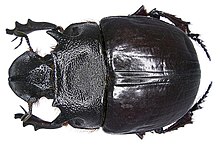Heliocopris bucephalus
| Heliocopris bucephalus | |
|---|---|

| |
| Scientific classification | |
| Kingdom: | |
| Phylum: | |
| Class: | |
| Order: | |
| Suborder: | |
| Superfamily: | |
| Family: | |
| Subfamily: | |
| Genus: | |
| Species: | H. bucephalus
|
| Binomial name | |
| Heliocopris bucephalus (Fabricius, 1775)
| |
| Synonyms | |
| |
Heliocopris bucephalus, commonly known as the Elephant dung beetle,[1] is a species of dung beetle found in India,[2] Sri Lanka, Bangladesh, Myanmar, Malay Peninsula, Java, Vietnam, Laos, and Cambodia.[3][4][5]
Description
[edit]This large, broad, globular, and quadrate species has an average length of about 39 to 55 mm. The body is black whereas the elytra and ventrum are usually deep red in color. The legs and ventrum are covered with coarse rust-red hair. They have a small head and the pronotum is coarsely rugose. The elytra are very smooth, shiny, and very lightly striate. The clypeus is moderately fine, whereas the vertex is more coarse and transversely strigose. The pronotum is either very unevenly rugose or reticulate.
Males are smaller and more red than females. Females are almost entirely black in color. Males possess a slender, curved, and pointed horn. They also have a maximum and minor phase with changes in the head and pronotum. In females, the head is strongly transverse with transverse carina.[6][7]
Adults are common at night, in the months of August and September.[8] The urease-negative basidiomycetous yeast called Trichosporon heliocopridis is known to be associated with adult beetles of the species.[9] In Thailand, the species is considered an edible food.[10]
References
[edit]- ^ "Heliocopris bucephalus species page". THAILAND NATURE PROJECT. Retrieved 2021-07-22.
- ^ "Taxonomic studies on Lamellicorn Scarabaeids (Coleoptera) of Simbalbara Wildlife Sanctuary, Sirmour, Himachal Pradesh, India" (PDF). A Journal of Indian Zoology: Volume 112 (Part-I) Year 2012. Retrieved 2021-07-22.
- ^ "Heliocopris bucephalus (Fabricius, 1775)". www.gbif.org. Retrieved 2021-07-22.
- ^ Kunthiphun, Sineenath; Endoh, Rikiya; Takashima, Masako; Ohkuma, Moriya; Tanasupawat, Somboon; Akaracharanya, Ancharida (2016-03-01). "Trichosporon heliocopridis sp. nov., a urease-negative basidiomycetous yeast associated with dung beetles (Heliocopris bucephalus Fabricius)". International Journal of Systematic and Evolutionary Microbiology. 66 (3): 1180–1186. doi:10.1099/ijsem.0.000850. PMID 26674642. Retrieved 2021-07-22.
- ^ "Scarab Beetles (Coleoptera: Scarabaeoidea) of Melghat Tiger Reserve, Central India". Academic Journal of Entomology 5 (2): 73-80, 2012. Retrieved 2021-07-22.
- ^ "Heliocopris bucephalus (Fabricius, 1775)". India Biodiversity Portal. Retrieved 2021-07-22.
- ^ "Collecting Heliocopris the world's largest dung beetles". SCARABS. Retrieved 2021-07-22.
- ^ "Morphology of the head capsule and mouth parts of Heliocopris bucephalus fabre (coleoptera, polyphaga, scarabæoidea, scarabæidæ, coprinæ)" (PDF). Proceedings of the Indian Academy of Sciences. Retrieved 2021-07-22.
- ^ Kunthiphun, Sineenath; Endoh, Rikiya; Takashima, Masako; Ohkuma, Moriya; Tanasupawat, Somboon; Akaracharanya, AncharidaYR 2016 (2016). "Trichosporon heliocopridis sp. nov., a urease-negative basidiomycetous yeast associated with dung beetles (Heliocopris bucephalus Fabricius)". International Journal of Systematic and Evolutionary Microbiology. 66 (3): 1180–1186. doi:10.1099/ijsem.0.000850. PMID 26674642. Retrieved 2021-07-22.
{{cite journal}}: CS1 maint: numeric names: authors list (link) - ^ "Fatty acid composition of some edible dung beetles in Thailand" (PDF). International Food Research Journal 17: 1025-1030 (2010). Retrieved 2021-07-22.
